This site is supported by our readers. We may earn a commission, at no cost to you, if you purchase through links.
We’ve all been there; you have a cozy couch that has seen better days. A telltale sign of its age: pilling. Pilling is when the fabric on furniture or clothing becomes tangled and bunched up, creating little balls on the surface of the material.
We’re here to show you how to de-pill your couch so that it looks like new again in no time at all! With our step-by-step guide, we’ll take you through everything from gathering materials to removing loose fibers with tape or vacuum – by following our instructions closely, your beloved sofa will soon be back into shape in no time.
So grab a cup of coffee (or tea!) and get ready for some serious de-pilling action – let’s get started!
Table Of Contents
What is Couch Pilling?
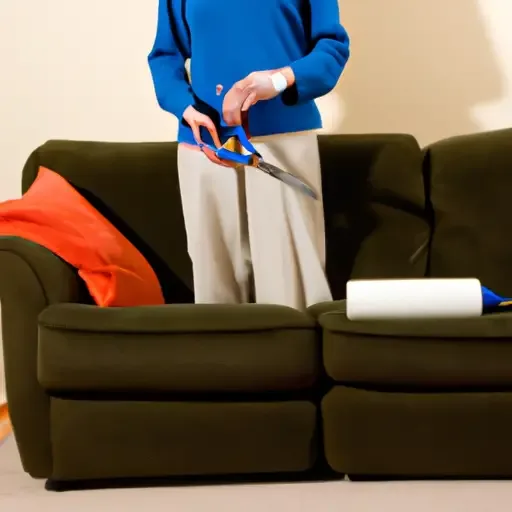
Couch pilling is a common issue that occurs when fibers in the fabric rub together and accumulate, forming small piles. To prevent this from happening with upcycled furniture or sustainable fabrics, it’s important to blend colors properly when second-hand shopping and dust regularly.
The best way to remove existing pills is by using a razor in short strokes along the direction of fibers. Tap frequently for built-up pills and use a vacuum with an upholstery brush attachment for loose fibers.
With minimal effort and cost required, it’s worth giving this trick a try. Happy de-pilling!
Causes of Couch Pilling
We all know how frustrating it can be when our couches start to pill, but understanding the causes of couch pilling can help us prevent or reduce future occurrences.
One common cause is transferring rug fibers from a rug onto the couch while moving furniture around – this is especially true if fabric softener was used on the rug.
Additionally, different types of fabric weave may lead to more or less pilling depending on how tightly they are woven together.
If your pet has been lounging around your sofa, their hair may also contribute towards further pilling as well!
Pills can form easily and quickly so it’s important that we take preventive measures like regularly vacuuming with an upholstery brush attachment and using lint rollers for pet hair removal in order to keep our couches looking good longer.
By being mindful about these potential sources of increased friction between fabrics during everyday activities like playing board games with friends or family movie nights, we’ll have a much easier time keeping them free from pesky pills!
With some simple prevention methods and regular maintenance routines in place, we’ll be able to extend the life (and look) of our beloved sofa for many years ahead, transitioning smoothly into discussing how to remove piling from a couch.
How to Remove Pilling From a Couch
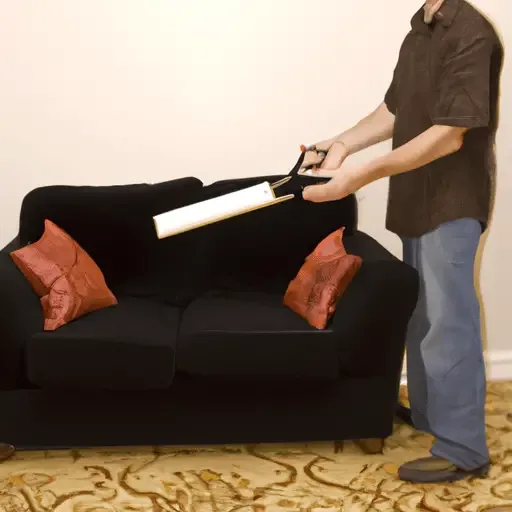
Start shaving in short strokes along with direction of fibers while tapping on the razor frequently to keep it free of built-up pills; adjust pressure as necessary for different fabric weaves.
Gather Materials
Let’s get our materials ready for de-pilling the couch! To prepare, we’ll need a few items: pet proofing supplies, fabric softener, lint rollers, and some DIY tips.
If you’re dealing with any stains on your furniture before de-pilling it, make sure to use stain removal products first or else they may become more visible after removing pilling.
Once you have all your materials gathered together, it’s time to start prepping the area around the couch for cleaning. Before starting on this step, make sure that there’s enough space around the sofa so that no pieces of furniture will be disturbed when working in between them and other objects next to them.
Prepare the Area
Let’s get our space ready for a pilling-free couch! We’ll make sure everything around the sofa is secure and clear of any obstructions so we can easily access every inch of fabric to remove those pesky fibers.
Before beginning, it’s important to keep in mind that different fabrics require different cleaning techniques. For upholstery, try using lint rollers or vacuum attachments specifically designed for pet hair removal.
To prevent further damage from occurring during maintenance, use DIY tips like testing an inconspicuous area first on delicate fabrics such as silk or velvet. This way you’ll know how they react when exposed to moisture or soap strips found in many razors.
With the right preparations made ahead of time and knowledge about various fabric types, your task should be finished efficiently with minimal effort!
Shave the Couch
We’re now ready to start ridding the couch of its pills, so let’s grab a new and sharp razor and get shaving! Artificial fur can be particularly pesky when it comes to pilling. DIY options like fabric softeners or cleaning solutions aren’t always effective for this task.
That’s why we rely on household tools like our trusty razor to do the job right.
Here’s what you need:
- A new and sharp razor
- Tape or vacuum cleaner with upholstery brush attachment
- An area that’s been cleaned prior to de-pilling
Start with the lightest contact when using your razor. Increase pressure as needed while pulling fabric tight in one hand. Shave short strokes along the direction of fibers, tapping frequently to remove built-up pills.
Use tape or a vacuum afterward for any loose fiber left behind in order to achieve the best results from your efforts.
To prepare the area properly before getting started will ensure an easier process, so make sure everything’s clean before moving forward!
Shave in Short Strokes
We’re now ready to start ridding the couch of its pills, so let’s grab our sharp razor and get shaving in short strokes!
Before getting started, it’s important to familiarize yourself with eco-friendly methods that are suitable for your fabric type. Taking into consideration color fading or other pre-treatment techniques can make sure your results last longer.
When buying a new razor, be sure to pick one that’s up for the task; you’ll want it sharp and moisture-free without any soap strips on it.
Shaving should be done in short strokes along the direction of fibers as this will ensure minimal contact with the fabric while still removing built-up pilling efficiently.
With patience and practice, you can say goodbye to pesky pills – just remember not all fabrics respond equally well, so some research beforehand could save time later down the line!
Now we’ve prepared ourselves adequately, let’s move onto preparing our workspace prior to starting the de-pilling process properly.
Tap the Razor Frequently
We’re now ready to ensure the most efficient pilling removal by tapping our razor frequently in short strokes! To begin, it’s important to make sure that low pile fabrics are given extra attention when de-pilling.
If possible, prevention of future pilling should be considered such as pet proofing and eco-friendly solutions like fabric softeners.
Additionally:
- Start with the lightest contact possible on the fabric and increase pressure only if absolutely necessary.
- Tap the razor regularly throughout your de-pilling session so you can remove any built-up pills without damaging your couch’s material.
- Make sure you lay flat any clothing items before pulling them tight for a more efficient approach.
Using this method will not only help save time but also provide an effective solution that won’t damage or leave behind excess fibers from shaving off pills on your pillow or furniture surfaces – leaving them looking brand new!
With this knowledge, we’re prepared to start preparing our area for successful de-pillling sessions ahead!
Adjust Pressure as Needed
We adjust the pressure as needed to ensure we’re effectively and efficiently removing any pills without damaging our couch’s material. Exercise caution when using a razor, and use lint rollers for larger areas in between spot treating stains with tweezers.
We also try shaving smaller sections of fabric if necessary, but be careful not to press too hard or else you could end up creating more pilling than before! To prepare the area properly, it’s important that furniture is vacuumed first to remove loose fibers so they don’t get caught up in the razor blade while de-pilling; this will help make sure we are successful at restoring our couch back to its original beauty after completing all steps.
Use Vacuum With Upholstery Brush Attachment
We use a vacuum with an upholstery brush attachment to capture any remaining fibers and ensure our couch looks like new. This is the most effective and efficient way of de-pilling as it gets even the hard-to-reach areas of fabric.
It’s also an excellent choice for those looking for more power than what lint rollers or steam cleaning can provide.
The suction created by the vacuum, combined with gentle scrubbing from the upholstery brush attachment, breaks down pilled fibers and easily lifts them away from your furniture surface without damaging its finish or texture.
To further prevent pilling, we also take advantage of fabric softener. When used during laundering, it reduces friction between clothes and prevents further accumulation, resulting in fewer pills on our couch over time.
Be Gentle With Looser Fabric Weave
When de-pilling, it’s important to be gentle with fabrics that have a looser weave, as too much pressure can cause damage. Excessive heat and poor maintenance of the fabric can lead to wear patterns in addition to pilling and should be taken into consideration when deciding how much pressure is needed for removal.
It’s also essential to consider the quality of the fabric. If it has been subjected to harsh cleaning frequencies or there is significant tonal variation between sections, then more care must be taken during de-pilling.
Taking all these factors into account will ensure successful results without causing any further damage from overworking the fibers in a looser material weave. Thus, careful attention must always be given during this process as it could mean making an old piece look new again or ending up with irreparable harm due to its delicate nature.
Clean the Couch
We give the couch a gentle clean before starting our de-pilling process. We make sure to pay attention to any worn or tonally varied areas of the fabric.
Making time for regular cleaning and maintenance is essential in keeping your couch looking its best. There are different methods available that suit various cost considerations as well as safety precautions.
Depending on what type of fabric you have, we use either a vacuum cleaner with an upholstery brush attachment or gently spot clean with mild detergent and warm water.
With proper care taken while cleaning, we move onto preparing the area for de-pilling.
Remove Loose Fibers With Tape or Vacuum
Now that we’ve given our couch a proper clean, let’s make sure no loose fibers remain by giving it a quick tape or vacuum sweep!
To do this effectively, we’ll need to:
- Use lint brushes on sagging cushions
- Vacuum with an upholstery brush attachment
- Apply fabric softener and steam cleaning for pet fur removal
- Lay the item flat and pull the fabric tight with one hand
- Tap the razor frequently to remove built-up pills
With these steps in mind, you can be confident all stubborn thread pieces will be gone.
Remove Dirt and Stains
Now that we’ve de-pilled our couch, let’s get rid of any dirt and stains to make sure it looks as good as new!
The type of upholstery fabric will determine what cleaning solution is appropriate for removing dirt and stains. For example, if your couch has a synthetic material like polyester or nylon, you can use an all-purpose cleaner with warm water.
It’s important to test the cleaning solution in an inconspicuous area first before tackling larger spots on your furniture.
If the fabric has a natural fiber such as cotton or wool, then you may need to vacuum more frequently since these materials are prone to collecting pet hair and other debris quickly due to their texture.
When using any cleaning solutions, always be sure to follow manufacturer instructions to protect your furniture from harsh chemicals found in some products.
Taking proper care of upholstery fabrics can help extend their life by preventing fading from direct sunlight exposure. So be mindful about positioning pieces away from bright windows or areas where UV rays may reach them directly.
With this knowledge under our belt, let’s prepare the area around our sofa for de-pillling success!
Can You Use Pilling Remover for Clothes?
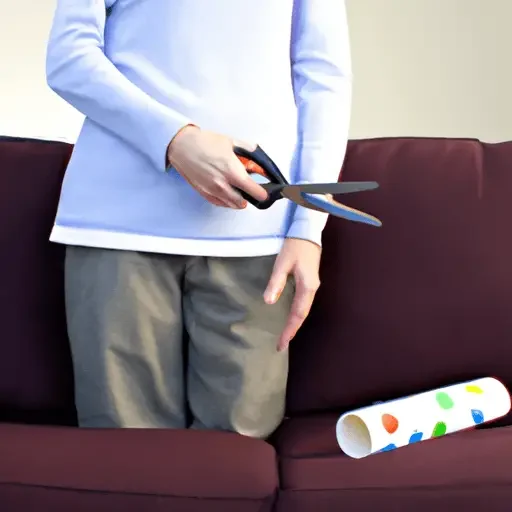
You can even try steam cleaning as a gentle approach if the fabric weave is loose.
With these tools, you’ll be able to remove those pesky pills quickly and make your clothing look like new again! Moreover, this method works just as well with clothes as it does with furniture. Pulling apart fibers in one direction while using a razor will do wonders for any item that has been through some wear and tear – no matter what type of fabric it’s made out of.
So before reaching for expensive stain removers or fabric protection sprays, give this trick a shot first.
More Cleaning Tips
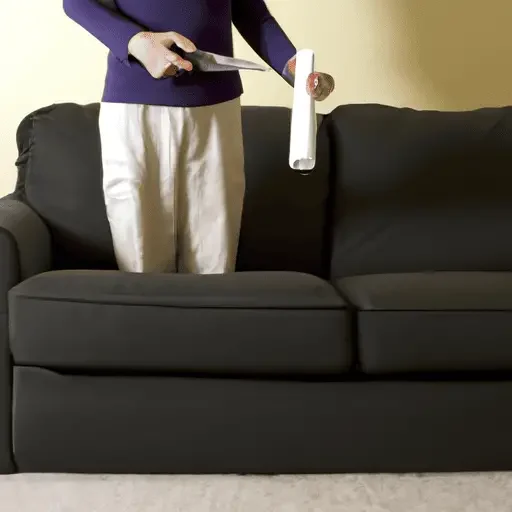
One way to tackle pilling is steam cleaning – this can help loosen fibers and make them easier to remove with lint rollers or tape. This is especially useful if pet fur has become embedded in the fabric over time.
For fabrics with longer threads, you may need to use a vacuum attachment brush as an additional tool when de-pilling.
With patience and some elbow grease, you’ll have your couch looking good as new before long – happy de-pilling!
Podcasts to Listen to While De-fuzzing
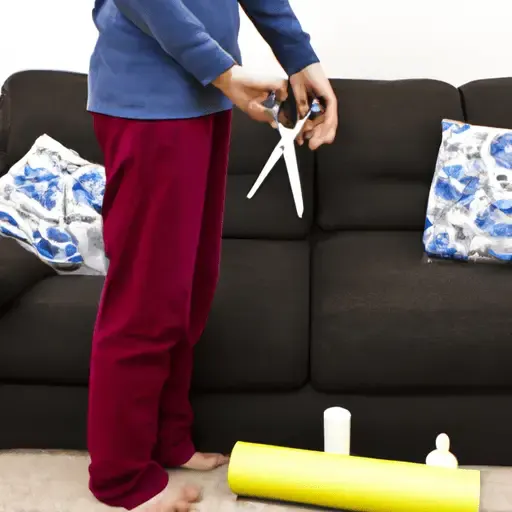
To keep our couches looking new for longer, we use lint rollers on a regular basis and also opt for professional cleaning when necessary. However, there are certain steps that can be taken before resorting to this more expensive option.
Using fabric softener during each wash helps reduce static cling from garments which can lead to pilling on furniture pieces such as sofas or chairs – reducing how often you need a deep cleanse is always beneficial both financially and time wisely!
We’ve found combining these two activities is an enjoyable way of taking care of our home furnishings without compromising quality – plus who doesn’t love catching up with their favorite podcast?
Frequently Asked Questions (FAQs)
How often should I de-pill my couch?
We all know the struggle of buying a new couch, only to find that it starts pilling after a few months or years.
To prevent wear in fabrics, you should de-pill them regularly depending on their type and usage. Hair removal also helps minimize fabric pilling. DIY solutions such as using tape or vacuuming with an upholstery brush attachment can be used for effective pill removal from couches and other furniture items.
So if you want your furniture looking like new again, try out this simple trick for removing pills today!
Is it okay to use a razor on a fabric couch?
We know that fabric couches can be tricky to take care of, especially when it comes to pet hair and lint. DIY solutions like lint rollers are sometimes not enough, though, so you may have heard about using a razor for de-pilling.
It’s important to be gentle with the fabric, though – make sure the weave is loose enough before beginning and always use short strokes in the direction of fibers.
With these simple steps, you’ll have beautiful fabrics again – happy de-pilling, everyone!
Is there any way to prevent pilling on my couch?
We’ve all been there – you look at your couch and it’s covered in unwanted pilling. To avoid this, there are preventative measures you can take. For example, avoid synthetic fabrics and opt for natural fibers instead.
Manual methods like brushing the fabric regularly with a lint brush or upholstery brush can also help reduce pilling. If that doesn’t work, chemical treatments may be necessary to break down the fiber buildup on your couch material before it becomes an issue.
So don’t let pilling ruin your furniture. Try these simple preventative measures today!
What kind of tape should I use to remove pilling?
We’ve all experienced the frustration of pilling on our clothing and furniture. However, removing them doesn’t have to be complicated or expensive – you just need a razor with some tape!
Start by laying your item flat and pulling the fabric tight as you shave in short strokes along the direction of fibers. Tap frequently to remove built-up pills but use the lightest contact first before increasing pressure if needed for more stubborn areas.
You can also vacuum up loose fibers after de-pilling with an upholstery brush attachment for best results! With this easy trick using natural alternatives like tape instead of harsh chemicals, even worn items can look like new again in no time.
Happy de-pilling!
Does de-pilling damage the fabric of my couch?
We’ve all been there – you’re snuggled up on the couch with your favorite blanket and pet, only to realize that it’s covered in pilling. It can be tempting to reach for a lint roller or DIY cleaning solution, but before doing so, it’s important to consider whether de-pilling will damage your couch fabric.
The good news is that when done correctly and carefully, de-pilling won’t cause any harm! With some patience and an old razor blade (or even better yet – a brand new one!), you can remove those pesky pills without damaging the fabric of your beloved piece of furniture.
Just remember: work slowly by shaving in short strokes along the direction of fibers; tap the razor frequently; keep contact light at first; use vacuum attachments for loose fibers afterwards; oh.
Conclusion
We hope this article has been helpful in teaching you how to de-pill your couch. With the right materials and a little bit of effort, you can make your couch look like new again.
You might be surprised to learn that over 50% of couches in the US have some degree of pilling. So, you’re definitely not alone in this battle. And with our tips, you will be able to restore your couch to its former glory.
So, gather your materials and get to de-fuzzing!






